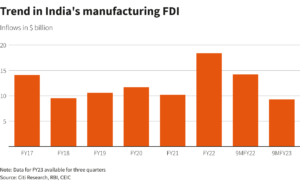India, currently the fifth-largest economy in the world, is predicted to surpass Japan to reach the third position by 2030, with a GDP of $7.3 trillion. The Indian economy grew rapidly in 2021 and 2022, but in the 2023 calendar year, it continued to grow strongly and sustainably.
India is predicted to have the fastest-growing major economy this fiscal year, with its gross domestic product (GDP) estimated to increase by 6.2–6.3% in the fiscal year that ends in March 2024. The third-biggest economy in Asia expanded spectacularly by 7.8% during the April–June quarter.
The past ten years have seen an acceleration of foreign direct investment (FDI) into the country, which is consistent with the country’s favorable long-term development forecast. This strong threshold is supported by India’s youthful demographic profile and rapidly expanding urban family incomes.
“India’s nominal GDP measured in USD terms is forecast to rise from USD 3.5 trillion in 2022 to USD 7.3 trillion by 2030,” the analysis by S&P Global stated. Due to this boom, GDP is expected to surpass that of Japan by 2030, making it the second-biggest economy in the Asia-Pacific area.

Key Points for India
- Projection for GDP : The Indian economy was estimated to be worth USD 2.7 trillion in 2021 and is expected to reach USD 8.4 trillion by 2030. With this growth, India’s economy will surpass that of Japan and rank second in the Asia-Pacific area by 2030.

- The growth rate is expected to drop by 7.3% in the previous fiscal year to 8.2% in 2021–2022.
But the current fiscal year’s (FY) pace will carry over into 2022–2023 and India will grow by 6.7%. - Different Indian sectors : The sectors of e-commerce, manufacturing, infrastructure, and services all contribute significantly to increased growth rate.
In addition, as the world grows more digitally connected, the e-commerce sector will grow during the next several years.
A research estimates that by 2030, 1.1 billion Indians-500 million in 2020-will have internet access. - Growth Rate : The Indian economy appears to have a bright and steady future, positioning it as the nation with the fastest growth rate over the next ten years.
Long-term technical advancements like those in the infrastructure industry and startups will be crucial to maintaining it’s strong economic growth.
India’s economy, which is among the fastest-growing in the world, will make it a key long-term growth market for multinational corporations operating in a variety of sectors, including the manufacturing (autos, electronics, chemicals), services (banking, insurance, asset management, healthcare, and IT), and services (insurance). - Support from Middle-class : The largest consumer group, the middle class, provides the greatest assistance.
Over the following ten years, consumer expenditure will likewise double. By 2030, this might have grown to USD 3 trillion from USD 1.5 trillion in 2020. - Inflows of FDI’s : In 2020 and 2021, there will be a significant continuation of the noticeable five-year increase in Foreign Direct Investment (FDI) inflows.

Large infusions of capital from international technology multinational corporations (MNCs) drawn to it’s sizable domestic consumer market, like Google and Facebook, are supporting it. - Current State : According to the provisional estimates of gross domestic product for the first quarter of 2021–22, India’s GDP at current prices was USD 694.93 billion in the first quarter of FY22.
The country has more than 21 unicorns with a combined valuation of USD 73.2 billion, making it the fourth-largest unicorn base in the world.
The Boosting economy
- In September 2021, significant improvements to the telecom sector were approved. These changes are anticipated to improve consumer interests, competition, growth, and employment.
The main measures include encouraging spectrum sharing, rationalizing bank guarantees (BGs), and rationalizing adjusted gross revenue. - Production-Linked Incentive Program (PLI) across Multiple Industries.
- The National Policy on Electronics 2019 (NPE 2019) and “Make in India”.
- On August 2021, the Indian government approved the Deep Ocean Mission (DOM), allocating Rs. 4,077 crore (USD 553.82 million) for the project’s five-year budget.
- In order to generate energy, focus is on renewable sources. It plans to achieve 40% of its energy from non-fossil sources by 2030, up from 30% currently, and to increase its renewable energy capacity from to 175 gigatonnes (GW) by 2022.
- Alongside, India and the United Kingdom jointly launched a ‘Roadmap 2030’ in May 2021 to collaborate and combat climate change by 2030.
Way Ahead for India
Some industries, like manufacturing and construction, had a gradual recovery in 2021, low-skilled workers, women, independent contractors, and small businesses were left behind.
To drive structural growth, two key pillars should be employed: manufacturing and infrastructure.
Nonetheless, the private sector would also need to begin making contributions if infrastructure were to be built or if the investment cycle were to be revived generally.
The conditions are setting up for a private business and household rebound: banks and other financial institutions are in a stronger position; corporations are deleveraging; and interest rates are still low.
The rate of recovery of household incomes and the normalization of small-scale business and informal sector activities will determine how quickly the Indian economy expands in FY22.
To encourage the private sector to generate wealth over an extended period of time, making living and doing business more convenient should be made possible.
India’s success is largely due to the participation of women in the workforce. India should thereby boost the proportion of women in the workforce.












Comments 3